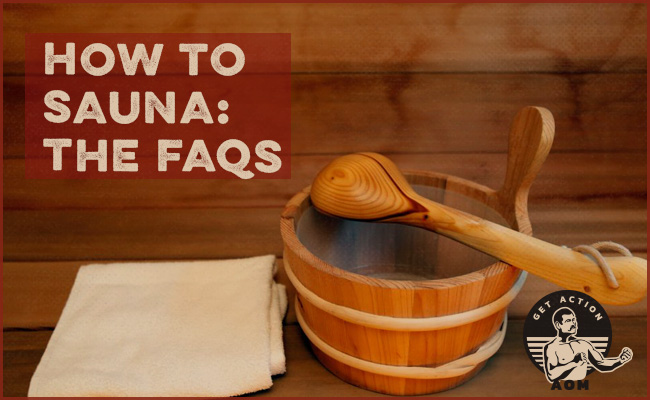
Last week, we covered the many mental and physical benefits of spending time in a sauna. If you were inspired to get more heat exposure in your life, today we cover all the questions you may have about making this practice a regular ritual.
How to Choose a Sauna
Should I Go Finnish or Infrared?
Saunas fall into two types: Finnish or infrared. They both make you hot and sweaty, but do so in different ways.
Finnish saunas. This is a traditional sauna. A Finnish sauna uses a heater (wood-burning or electric) to heat the air in a wood-paneled room or barrel. The air temperature in traditional Finnish saunas ranges from 160 to 220 degrees Fahrenheit, with the typical temp of 190-200. The superheated air is what heats your body through the process of conduction.
Most of the studies that have been done on the benefits of saunas were done using Finnish saunas.
Infrared saunas. Instead of heating up the air in the room to heat up your body, infrared saunas use near and far thermal radiation waves to heat your body directly. Sort of like getting cooked in a microwave. That might sound questionable, but the waves are safe and won’t give you cancer or turn you into a mutant. Because infrared saunas can heat your body directly, they don’t have to get the room as hot as a Finnish sauna to get you all hot and sweaty. Infrared saunas don’t feel as hot as Finnish saunas, but you still get similar benefits.
The type of sauna you go with is a matter of personal preference and budget. Infrared saunas are more inexpensive, and require less energy and a smaller footprint (people put them in bedrooms/garages/basements) than Finnish saunas. If you also don’t like the feeling of super-hot air that you experience in a Finnish sauna, then infrared may be the right choice for you.
If you’ve got the room and budget, and want the traditional sauna experience, then I would recommend the Finnish style as the way to go. I don’t think the benefits of sauna sessions come completely from the heat alone; it’s not like popping a supplement. Rather, I’d venture to say that its healthifying effect derives from an amalgamation of the heat itself, and the ritual of it. There’s something about the feel and smell of the wood, being able to throw water on the rocks to create a cloud of steam, and the hot, hot air. Feels good, man.
The other nice thing about Finnish saunas is they can be pretty large, and you can put them outside. My sauna from Almost Heaven can comfortably sit six grown men and resides in the backyard; it’s nice having a “third space” apart from the house, getting some fresh air as you walk to and from it, and being able to see a little nature outside its glass door.
Where Can I Find/Buy a Sauna?
Saunas are available at gyms, health clubs, and tanning salons.
If you’re interested in buying your own, you can get saunas direct from sauna manufacturers as well as on Amazon and even from Costco.
If you’re looking for a reasonably-priced Finnish sauna, check out Almost Heaven. As just mentioned, that’s where I got mine. Make sure to check their site regularly; they constantly have sales.
How to Sauna
Precautions With Sauna
Before we get into the nitty gritty of sauna-ing, it’s worth emphasizing that the heat of a sauna acts as a physiological stressor, and you should take precautions before using one if you:
Have heart issues. As mentioned in our previous article, sauna sessions give your cardiovascular system a workout. If you have heart issues, talk to your doctor before using a sauna.
Take prescription medications. Certain medications don’t mix well with heat exposure. If you’re taking any prescription medications, talk to your doctor before using a sauna.
Have certain skin conditions. Sauna-ing can be good for skin, as it increases blood flow and circulation, bringing more nutrients to the skin. But it can be bad for skin if you have certain conditions.
The hot air in a sauna can exacerbate skin problems like eczema and rosacea. For eczema sufferers, adding steam can mitigate that, and some claim that using an infrared sauna can actually help the condition.
While you might have heard that sauna-ing is good for acne, because it opens up your pores, the heat, steam, and resulting sweat can actually inflame those pores, and exacerbate breakouts, especially if you have a type of acne which involves inflammation, like cystic acne. If you’re prone to acne and still want to sauna, be sure to wash your face soon afterwards to cleanse it of residue.
Are concerned about your fertility. As explained in our article about male fertility, the reason why testicles reside outside the body is to keep them cool. Sperm counts decrease as the temperature increases. Sitting in a sauna warms up your testicles, resulting in decreased sperm counts and motility.
These effects aren’t permanent and are quickly reversible. You just have to stop using a sauna for a while.
If you’re trying for kiddos, consider foregoing the sauna. Try a cold shower instead.
How Hot Should a Sauna Be?
Researchers haven’t determined a precise temperature and time for optimizing the benefits of sauna sessions, but you generally want them to be pretty hot and of a moderate length (more on that below).
Studies that have been done on the health-promoting effects of sauna sessions have often set the temperature for participants around 180-200 degrees Fahrenheit. My usual go-to sauna temperature is 210.
If I plan on having a long bull session with my dudes, I’ll start off with the temperature at 130 degrees Fahrenheit. It’s more like a sweat lodge experience than a sauna. Low and slow. When the night is done, we finish with 10-15 minutes with the sauna at 210 degrees.
For infrared saunas, shoot for the air to get heated to between 175 and 195 degrees.
How Long Should a Sauna Session Be?
20-30 minutes is the traditional sauna length for Finnish saunas, and most of the studies cited in our previous article had participants sit in the sauna for at least 20 minutes.
But the length of your session will really depend on the temperature you set: if it’s high, a shorter, 15-20 minute session will do the trick; if the temp is low, you can go much longer. On my sauna nights with friends, we’ve slowly, yet comfortably, cooked in the sauna at 130 degrees for 90 minutes.
If you’re using an infrared sauna in that 175 to 195 degree range, 20 minutes is all you need to get hot and sweaty.
You can divide up sauna sessions with cooling breaks. When my pool is open during spring, summer, and early fall, I intersperse my sauna sessions with jumps into the water. During the winter, I just step outside the sauna and walk around in the cold for a few minutes before getting back in.
With the duration of your sessions, the bottom line is really to just listen to your body: first you’ll feel warm, and then hot, and then hot and kind of uncomfortable (but in a satisfying way) . . . and then eventually you move beyond just kind of uncomfortable to feeling like, “Okay, this is too much, I’m done.” That’s the time to either take a break, cooling off before getting another dose of heat, or to just call it a session. Listen to your body!
How Frequently Should I Sauna?
You could sauna every day if you wanted.
But keep in mind that, again, sauna-ing is a stressor on your body. There’s a balance you have to walk with it. At the right dose, sauna sessions can help you recover from life and workouts. Too much though, and they can actually increase your fatigue. You can get the benefits of sauna-ing with just two 20-minute sessions a week. Experiment to see what works for you, and again, listen to your body; once you tune in, you can actually feel your body kind of “craving” a sauna session, or conversely, saying, “Now’s not the right time.”
I try to get three sauna sessions in a week. That number seems to work for me.
When Should I Sauna?
You can sauna whenever you want, but if you have a fitness program you’re following, you’ll want to avoid doing the sauna right before a workout. Not to beat a dead horse here, but remember, heat is a stressor. Stressing your body with heat before you stress your body with exercise is a recipe for poor performance. If you exercise regularly, try to do your sauna sessions on your rest/recovery days or right after your workout.
What Should I Do in a Sauna?
I’ve seen people bring their phone into the sauna to listen to music or a podcast, but the heat isn’t good for your phone, and sauna sessions are an optimal time to disconnect from your tech and from all the annoying distractions of your life. Let the sauna be your sanctum sanctorum.
You might think about bringing a paperback into the sauna with you, but your focus/higher level thinking skills will diminish as your body heats up and your heart rate rises. Plus, your hands are going to get way too sweaty for holding a book.
You can do light stretches and bodyweight exercises if space allows. Your muscles will feel nice and limber and supple. Keep in mind though that your body is already being taxed by the heat, so any kind of movement will require much more exertion than usual; take it easy and listen to your body.
In general, I recommend simply doing in the sauna what traditional sauna-ers have long done: nothing. Just sit there. Or lie down if you have the room (you’ll find it’s hotter when you sit up though, as hot air rises). Let your mind go. Do some reflecting while your thinking is still sharp; meditate when your mind starts going blank. Just be.
What Should I Do After I Sauna?
During your sauna session, you’ll lose a lot of water through your sweat — up to four cups during a twenty-minute session! Be sure to rehydrate with plenty of water afterward. Supplement with electrolytes as needed.
You’ll be incredibly sweaty afterwards, so you’ll likely want to shower; a cold one will feel great (and be far more tolerable than usual)!







